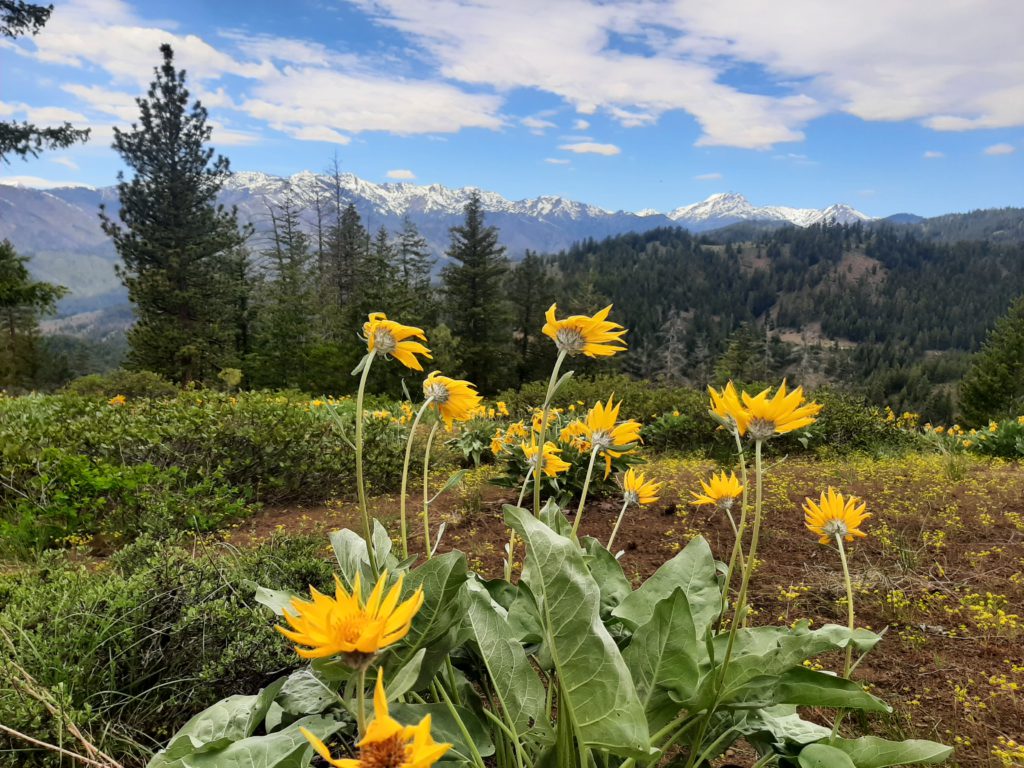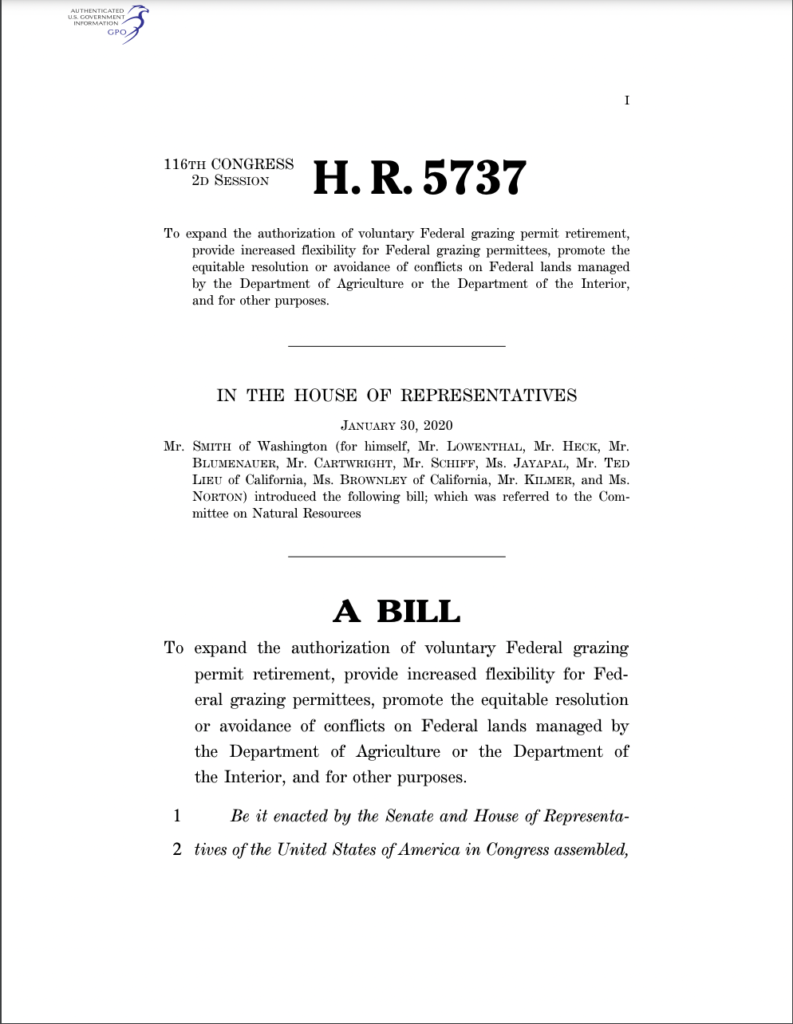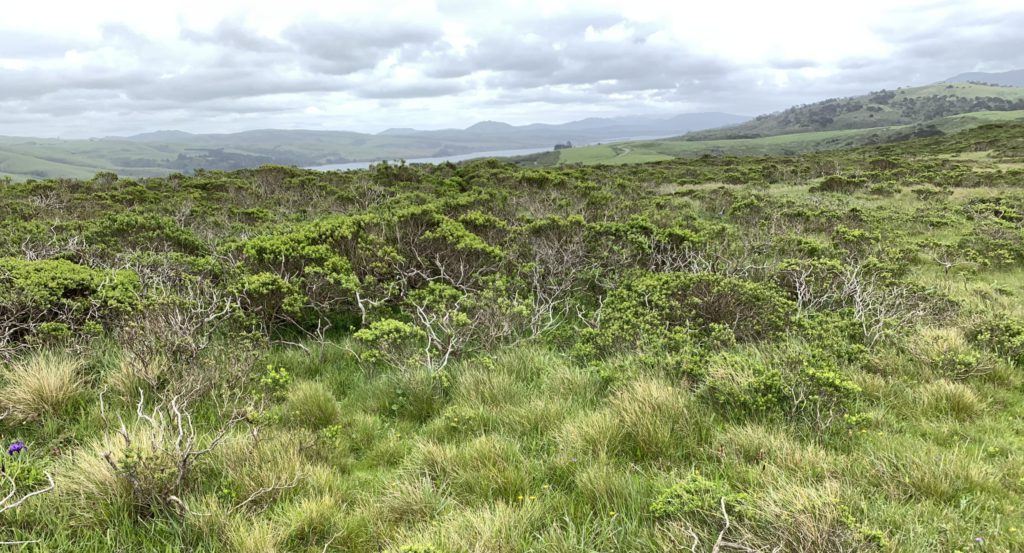Congressional Toolkit
Introduction, and how to use this toolkit:
The Bureau of Land Management (Bureau) manages a total of 245.7 million acres, primarily in the West. Of total Bureau land, roughly 154 million acres are currently available for livestock grazing. The U.S. Forest Service (USFS) manages a total of 192.9 million acres. Of total USFS land, more than 93 million acres are available for grazing, with about 74 million currently used for livestock grazing.
On Bureau rangelands, in FY2017, there were 16,357 operators authorized to graze livestock, and they held 17,886 grazing permits and leases; on USFS rangelands, in FY2017, there were 5,725 permit holders permitted to graze commercial livestock, with a total of 6,146 active permits (Congressional Research Service 2019).
As outlined in the “Key Problems” section, there are many indications that the current federal grazing program on our public lands is not helping to maintain these lands in a healthy ecological state. Congress can play an important role in ensuring that these lands can become healthier again. There are bills now before Congress that need to be acted on, some which can help our rangelands, and some which will not.

This toolkit provides information on:
Ecological Science
A brief overview of the published science that demonstrates the ecological effects of livestock grazing
How Congress Can Help
What Congress can do to address the current problems with public land livestock grazing
GAO Reports
A collection of Government Accountability Office reports that have addressed some of these livestock issues

Current Legislation to pay attention to, NOW!
Voluntary Grazing Permit Retirement Act.
As described on the “problems” page, there are many willing ranchers out there interested in receiving compensation for ceasing grazing (the value of the base property is in part tied to the number of AUMs in the associated public lands grazing permit, thus validating the concept of “compensation” for not grazing). It would be easier – and more just – for the federal government to fairly compensate the permit holders as it reduces cattle numbers on federal lands. Since, as described above, the government spends substantially more than it receives for grazing, in a few years the savings realized by reducing livestock numbers can effectively pay for much of the compensation (Kerr 1998). In the end, it will be less expensive – fiscally and politically – for the agencies to simply buy out the problematic grazing permits and save extensive planning, monitoring, research, public involvement, appeal, litigation and political costs (Kerr 1998).
The Key Problems:
Most federal lands are in poor shape due to grazing, or land health status is unknown.
Click here for more explanation on how 50% of Bureau lands currently fail to meet the federal Standards for Rangeland Health, by the agency’s own assessment, and how 91% of USFS managed allotments do not have a current National Environmental Policy Act (NEPA) assessment (i.e., no NEPA in at least the last 10 years). This is unacceptable; these agencies must be held to a higher standard for completing these important assessments which are critical for identifying where management change is needed.
Continuing “grazing as usual” combined with drought.
Click here for more information on how neither the Bureau nor the USFS are equipped, with the constraints of their current livestock management strategies, to effectively deal with the long-term and crippling drought that is currently ravaging the western states and their fragile ecosystems. At a minimum, stocking rates must be reduced across the board – and quickly – to escape even worse long-term ecological outcomes from the current drought.
Grazing in wilderness.
Click here for more details on a practice that most Americans are currently unaware of: livestock grazing in our federally designated Wilderness Areas (about a quarter of them to be exact). The current situation (i.e. Congressional Grazing Guidelines on wilderness being interpreted far too liberally; too many exceptions for motorized use by ranchers; and a rush to fill vacant grazing allotments in wilderness, just to name a few examples) is unacceptable. Major reform is needed, and Congress can and should take the lead on it.
Trespass cattle on federal grazing lands.
As summarized in GAO Report 16-559, the frequency and extent of unauthorized grazing on BLM and USFS lands are largely unknown because according to agency officials, the agencies prefer to handle most incidents informally (e.g., with a telephone call) and do not record them. Despite this, GAO report 16-559 found that the agencies’ databases contained information on nearly 1,500 incidents of unauthorized grazing where formal action was taken by the agencies’ range program or law enforcement staff for grazing years 2010 through 2014. Unauthorized grazing incidents were recorded in the agencies’ databases when the agencies billed a penalty for unauthorized grazing or prepared a law enforcement report. However, agency staff told GAO that they handle most incidents informally—their preferred practice—and do not record them in databases or consistently in paper files, because, in part, they do not consider it a priority. As a result, the agencies have incomplete information on the extent of unauthorized grazing. Federal internal control standards call for clear documentation of all transactions and other significant events. Until the agencies require that all incidents of unauthorized grazing be recorded, including those incidents resolved informally, BLM and the Forest Service will not have a complete record of unauthorized grazing incidents with which to identify any potential pattern of violations. This is a very serious problem.
The federal grazing fee.
Click here for more details on the long-acknowledged (by Congress) problem of the under-priced federal grazing fee, which does not come close to covering the cost of the federal grazing programs on USFS and Bureau lands, and can lead to overgrazing and resource damage. Because this issue is a political one is not reason enough to ignore it.
Difficulty with enabling willing ranchers to be bought out of their permit.
Click here for more explanation of the need for a federal grazing permit buy-out program. The time is ripe for this, as many grazing permit operators are ready to get out of the business but it’s currently very difficult to orchestrate the buy-outs that many ranchers would be in favor of enacting. As it turns out (see “Congress can enact solutions…” section below), the economics pan out in favor of the Voluntary Grazing Permit Retirement Bill, now before Congress.
Discover More
BLM and USFS Regulations and Handbooks
Explore an overview of BLM and USFS Regulations and Handbooks, including 36 CFR 222 (Forest Service Grazing Management), BLM M-4100 (Handbook and Grazing Policy Manual) and BLM H-4180 (National Rangeland Health Standards)
Relevant legislative history on grazing Issues
Explore an overview of relevant legislative history on grazing issues, including the Taylor Grazing Act, the Federal Land Management and Policy Act, the National Forest Management Act, the Public Rangelands Improvement Act, and many others
The science and data proving the problems
Explore an overview of some of the chief, most cited literature that illustrates the ecological consequences of livestock grazing and links to other scientific resources
Congress can enact solutions to above problems
Explore more explanation of current legislation that is pertinent to grazing reform (or will hurt efforts to improve grazing) - importantly including the Voluntary Grazing Permit Retirement Act

Many GAO reports describe the issues and problems above
Literature Cited
Congressional Research Service. 2019. Grazing Fees: Overviews and Issues. RS 21232.
Mack, R.N and J.N. Thompson. 1982. Evolution in Steppe with Few Large, Hooved Mammals. The American Naturalist 119(6):
